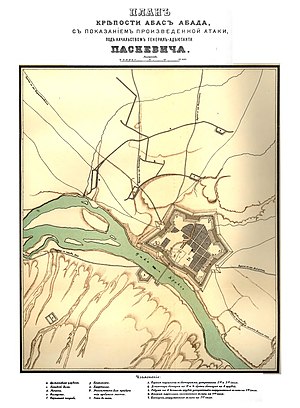
The Russo-Turkish War of 1828–1829 resulted from the Greek War of Independence of 1821–1829; war broke out after the Ottoman Sultan Mahmud II closed the Dardanelles to Russian ships and in November 1827 revoked the 1826 Akkerman Convention in retaliation for the participation of the Imperial Russian Navy in the Battle of Navarino of October 1827.
The Russo-Persian Wars or Russo-Iranian Wars were a series of conflicts between 1651 and 1828, concerning Persia and the Russian Empire. Russia and Persia fought these wars over disputed governance of territories and countries in the Caucasus. The main territories disputed were Aran, Georgia and Armenia, as well as much of Dagestan – generally referred to as Transcaucasia – and considered part of the Safavid Iran prior to the Russo-Persian Wars. Over the course of the five Russo-Persian Wars, the governance of these regions transferred between the two empires. Between the Second and Third Russo-Persian Wars, there was an interbellum period in which a number of treaties were drawn up between the Russian and the Persian Empires, as well as between both parties and the Ottoman Empire. Ottoman interest in these territories further complicated the wars, with both sides forming alliances with the Ottoman Empire at different points throughout the wars. Following the Treaty of Turkmenchay, which concluded the Fifth Russo-Persian War, Persia ceded much of its Transcaucasian territory to the Russian Empire.
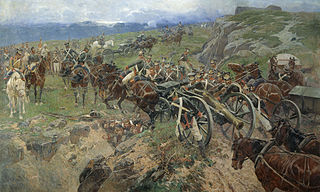
The Russo-Persian War of 1804–1813 was one of the many wars between the Persian Empire and Imperial Russia, and, like many of their other conflicts, began as a territorial dispute. The new Persian king, Fath Ali Shah Qajar, wanted to consolidate the northernmost reaches of his kingdom—modern-day Georgia—which had been annexed by Tsar Paul I several years after the Russo-Persian War of 1796. Like his Persian counterpart, the Tsar Alexander I was also new to the throne and equally determined to control the disputed territories.

The Nakhichevan Khanate was a khanate under Iranian suzerainty, which controlled the city of Nakhichevan and its surroundings from 1747 to 1828.

The Russo-Persian War of 1826–1828 was the last major military conflict between the Russian Empire and Qajar Iran, which was fought over territorial disputes in the South Caucasus region.
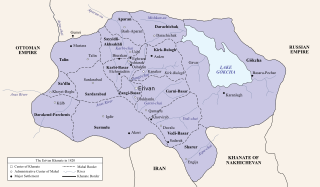
The Erivan Khanate, also known as Chokhur-e Sa'd, was a khanate that was established in Afsharid Iran in the 18th century. It covered an area of roughly 19,500 km2, and corresponded to most of present-day central Armenia, the Iğdır Province and the Kars Province's Kağızman district in present-day Turkey and the Sharur and Sadarak districts of the Nakhchivan Autonomous Republic of present-day Azerbaijan.
Hosein Qoli Khan Badkubeh was the last khan of the Baku Khanate, ruling from 1791 to 1806. During the Russo-Iranian War of 1804–1813, he supported Iran. He was ultimately forced to flee to Iran due to a rebellion by the inhabitants of Baku, who did not want to endure another Russian siege. His family adopted the name of Badkubeh after relocating to the city of Arak, whereas a different segment of the family that stayed and worked with the Russians adopted the name Bakikhanov.
Javad Khan ; c. 1748 – 1804) was a member of Ziyadoghlu Qajar, a clan of the Qajar tribe, as well as the sixth and the last khan of the Ganja Khanate from 1786 to 1804 before it was lost to Russia.

Hossein Qoli Khan Qajar Sardar Iravani was a statesman and commander in Qajar Iran, who was the last khan (governor) of the Erivan Khanate from 1807 to 1828.
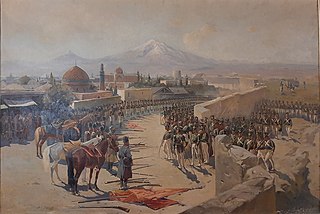
The Russian conquest of the Caucasus mainly occurred between 1800 and 1864. The Russian Empire sought to control the region between the Black Sea and Caspian Sea. South of the mountains was the territory that is modern Armenia, Azerbaijan, Georgia, and parts of Iran and Turkey. North of the mountains was the North Caucasus region of modern Russia. The difficult conquest of the intervening mountains is known as the Caucasian War. Multiple wars were fought against the local rulers of the regions, as well as the dominant powers, the Ottoman Empire and Qajar Iran, for control. By 1864 the last regions were brought under Russian control.

Abbasabad was a fortress of strategic importance for the defense of the Nakhichevan Khanate.

The siege of Ganja or assault on Ganja was the result of a Russian offensive in the South Caucasus intended to conquer the Ganja Khanate of Qajar Iran, which contributed to the escalation of the Russo-Persian War (1804–1813).

The siege of Derbent took place on 21 May [O.S. 10 May] 1796 during the Persian Expedition of 1796. Derbent, an ancient city with thick walls has a favorable geopolitical position, which locks the coastal passage between the Caucasus Mountains and the Caspian.
Ehsan Khan Kengerli, later known by his Russified name of Ehsan Khan Nakhichevansky was the last ruler of the Nakhichevan Khanate.

Dmitry Tikhonovich Lisanevich was a prominent general of Imperial Russian Army. He is best known for negotiation of The Treaty of Kurakchay and killing of Ibrahim Khalil Khan of Karabakh.
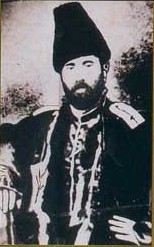
Ismail Khan Ehsan Khan oghlu Nakhchivanski was an Azerbaijani Cavalry General in Imperial Russian Army. He was the son of Ehsan Khan Nakhichevansky and uncle of Huseyn Khan Nakhchivanski. His brother Kelbali Khan Nakhchivanski was also Cavalry General in the Russian Imperial Army.
Ughurlu Khan or Oghurlu Khan was a claimant to Khanate of Ganja and a member Ziyadoghlu Qajar, a clan of the Qajar tribe.
Abbas Qoli Khan Kangarli was one of the rulers of the Nakhichevan Khanate in Afsharid Iran.
Karim Khan Kangarli is the last khan of the Nakhichevan khanate, whose reign lasted intermittently from 1808 to 1827. After the abolition of the Nakhichevan khanate in 1828, Ehsan Khan was appointed the governor of Nakhichevan under the rule of the Russian Empire.
